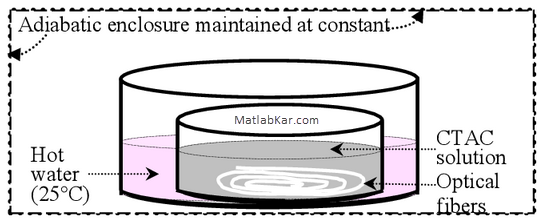
ایجاد تصویر حسگر نوری از داده های حرکتی در MATLAB
این مثال نحوه تولید یک فیلم با 64 فریم و اندازه فریم 64 در 64 پیکسل (با سرعت 10 فریم در ثانیه) را نشان می دهد. این فیلم شامل شبیه سازی یک هدف متحرک است که در حال حرکت در یک پس زمینه ساختار یافته می باشد و خود نیز در حال حرکت است. یک حرکت لرزش ناشی از ارتعاش تصادفی نیز ایجاد می شود (در یک مدل Simulink با نام aero_vibrati) و حرکت لرزش به حرکت کلی حسگر اضافه می شود. در نهایت، تصویر از طریق یک تابع گسترش نقطه نوری گاوسی تار می شود. توجه: تغییر جزئیات در اینجا مستلزم تغییر در کادر محاوره ای و تنظیم پارامترها در ارتعاش مدل سیمولینک می باشد.
| delt = 0.1; % Sample time of the generated sequence num_frames= 64; % Number of frames to generate framesize = 64; % Square frame size in pixels out = zeros(framesize,framesize,num_frames); % Initialize movie storage as a 3D Array |
تولید هدف و تعیین حرکت
اولین مرحله در تولید یک هدف و تعیین حرکت در آن، تعریف شکل ظاهری و حرکت شی مورد نظر است. شکل انتخاب شده یک علامت مثبت بزرگ است، و تصویر با ماتریسی که شدت تصویر را در هر موقعیت پیکسل نشان می دهد، تعریف می گردد. هدف به صورت حرکت از مرکز به سمت راست پایین تصویر تعریف می شود.
1 2 3 4 5 6 7 8 9 10 11 12 13 14 15 16 17 | target = [zeros(3,11) zeros(1,5) 6 zeros(1,5) zeros(1,5) 6 zeros(1,5) zeros(1,3) 6 6 6 6 6 zeros(1,3) % Target is a plus sign 5 by 5 pixels across zeros(1,5) 6 zeros(1,5) % with an intensity of 6 (S/N ratio is ~4). zeros(1,5) 6 zeros(1,5) % The total target image is made on an 11x11 grid to zeros(3,11)]; % allow the image to be interpolated without error. target_velx = 1; % target velocity in x direction in pixels per second target_vely = 1; % target velocity in y direction in pixels per second target_x_initially = framesize/2; % the target is initially in the center of the frame in x target_y_initially = framesize/2; % and in y figure(1); colormap('gray'); image(target*32); title('Target Image') |

ایجاد پس زمینه و انتخاب هدف از تصویر ترکیبی
یک پس زمینه با همبستگی سینوسی ایجاد کرده و یک حرکت انحرافی به آن بدهید. سپس، هدف را روی تصویر پس زمینه قرار دهید.
1 2 3 4 5 6 7 8 9 10 11 12 13 14 15 16 17 18 19 20 21 22 23 24 25 | backsize = framesize+36; % Make the background bigger than the frame so when it % drifts there are new pixels available to drift into. xygrid = (1:backsize)/backsize; B=2*sin(2*pi*xygrid).^2'*cos(2*pi*xygrid).^2; psd = fft2(B); psd = real(psd.*conj(psd)); background = B + 0.5*randn(backsize); % Add a specular Gaussian white % sequence to the structure with % variance of 0.25 (sigma of 0.5). xoff = 10; yoff = 10; % Sensor location is offset from the 0,0 of the background driftx = 1; drifty = 1; % drift rate of the background in a and y directions pix/sec. minout = min(min(min(background))); maxout = max(max(max(background))); colormap('gray'); image((background-minout)*64/(maxout-minout)) title('Background image with additive white specular noise') |

شبیه سازی ارتعاش چرخشی ردیاب
ارتعاش چرخشی ردیاب با استفاده از مدل aero_vibrati شبیه سازی شده است. داده های مورد نیاز برای شبیه سازی ارتعاش ردیاب با اجرای مدل aero_vibrati در محیط سیمولینک تولید می شود. مدل ارتعاش سیمولینک را با استفاده از دستور sim اجرا کنید. توجه داشته باشید که اگر delt از 0.1 ثانیه تغییر کرد، مدل سیمولینک نیز باید تغییر کند تا اطمینان حاصل شود که زمان نمونه برای لرزش با زمان نمونه در این مدل تصویر ردیاب مطابقت دارد. چرخش های تصادفی حاصله در شکل Figure 1 نشان داده شده است.
1 2 3 4 5 6 7 8 9 10 11 12 13 14 15 16 17 18 19 20 21 22 23 24 25 26 27 28 29 30 31 | omega = 2*pi*5; % The structural frequencies are 5, 10 and 15 Hz in the model. zeta = 0.01; % Damping ratio for all modes open_system('aero_vibrati') simout = sim('aero_vibrati','SrcWorkspace','current'); vibdat = simout.get('vibdat'); % The Simulink model "aero_vibrati" % generates the vibration data at % a sample time of 0.01 sec. vibx = vibdat(1:10:1000); % The output of simulation is % returned as the variable simout % The variable simout contains viby = vibdat(1001:10:2000); % the in array vibdat that contains % the vibration data levarmx = 10; % Rotational lever arm for vibration noise in x levarmy = 10; % and in y. subplot(211); plot(0.01*(1:10:1000),vibx);grid; title('Time history of the random Tracker rotations') xlabel('Time');ylabel('x direction') subplot(212); plot(0.01*(1:10:1000),viby);grid; xlabel('Time');ylabel('y direction') |


شبیه سازی جلوه های حرکتی، هدف و جیتر
فریم هایی که فیلم را تشکیل می دهند اکنون در یک آرایه چند بعدی (خارجی) ایجاد و ذخیره می شوند. هر فریم دارای پس زمینه و هدف در موقعیت های مختلف به دلیل حرکت هدف، انحراف پس زمینه و لرزش ردیاب است. اولین فریم فیلم در شکل Figure 1 نشان داده شده است.
1 2 3 4 5 6 7 8 9 10 11 12 13 14 15 16 17 18 19 20 21 22 23 24 25 26 27 28 29 30 31 32 33 34 35 36 37 38 39 40 41 42 43 44 45 46 47 | clf; drawnow; for t = 1:num_frames % Drift the Background at the rate driftx and drifty % (in pixels/second) and add in the vibration: xshift = driftx*delt*t+levarmx*vibx(t,1); yshift = drifty*delt*t+levarmy*viby(t,1); % Interpolate the 2D image using the MATLAB(R) function interp2: [xgrid, ygrid] = meshgrid(1:backsize); [xindex, yindex] = meshgrid(xshift:1:xshift+backsize,yshift:1:yshift+backsize); outtemp = interp2(xgrid,ygrid,background,xindex,yindex); % Truncate the drifted image down from backsize to framesize: out(:,:,t) = outtemp(xoff:xoff+framesize-1,xoff:xoff+framesize-1); % Now let the target move also: tpixinx = floor(target_velx*delt*t); tpixiny = floor(target_vely*delt*t); % Before interpolating extract the number of pixels moved txi = target_velx*delt*t - tpixinx; tyi = target_vely*delt*t - tpixiny; % Interpolate on sub-pixels around the origin only [txgrid tygrid] = meshgrid(1:11); % meshgrid here generates a matrix of grid elements [txi tyi] = meshgrid(txi+1:txi+11,tyi+1:tyi+11); % meshgrid generates 2 matrices with the x and y grids % Interpolate the intensity values first using interp2 -- a built in MATLAB command temp = interp2(txgrid,tygrid,target,txi,tyi); % Insert the target at the location determined by the initial offset, and the number of whole pixels moved tx = tpixinx + target_x_initially-1; ty = tpixiny + target_y_initially-1; out(tx:tx+6,ty:ty+6,t) = temp(9:-1:3,9:-1:3) + out(tx:tx+6,ty:ty+6,t); end minout = min(min(min(out))); maxout = max(max(max(out))); colormap('gray'); image((out(:,:,1)-minout) * 64/(maxout-minout)); title('First frame of combined target and background image.') |

تصاویر را از طریق اپتیک عبور دهید – از یک عملکرد دیافراگم گاوسی استفاده کنید.
عبور تصاویر از طریق اپتیک – استفاده از عملکرد دیافراگم گاوسی
در این بخش کد می توانید از یک تابع دیافراگم اندازه گیری شده به همین راحتی استفاده کنید. به سادگی پنج خط بعدی را با load measured_aperture جایگزین کنید، جایی که measured_aperture تابع اندازه گیری شده را در ASCII ذخیره می کند. داده های ذخیره شده در فایل measured_aperture.mat قرار دارد. این فایل mat حاوی تابع ماتریس است. برای راهنمای بیشتر و آشنایی با نحوه استفاده از mat فایل در متلب، دستور help load را تایپ کنید و به کد c و fortran نگاه کنید، در آنجا می توانید نحوه خواندن و نوشتن فایل های mat را مطالعه کنید. توجه داشته باشید که وقتی تابع Point Spread گاوسی است، تابع دیافراگم نیز گاوسی می باشد. برای شبیه سازی اثر اپتیک ردیاب، هر یک از فریم های فیلم اکنون با استفاده از یک FFT دو بعدی (تبدیل فوریه سریع) تار می شوند. اولین فریم از تصویر به دست آمده در شکل Figure 1 نشان داده شده است.
| x = 1:framesize; y = 1:framesize; sigma = 120; apfunction = exp(-(x-framesize/2).^2/(2*sigma))' * exp(-(y-framesize/2).^2/(2*sigma)); apfunction = fftshift(apfunction); % Rotate so it conforms with FFT convention for j = 1:num_frames out(:,:,j) = real(ifft2(apfunction.*fft2(out(:,:,j)))); end minout = min(min(min(out))); maxout = max(max(max(out))); colormap('gray'); image((out(:,:,1)-minout)*64/(maxout-minout)); title('First frame of blurred image.') |

تولید و پخش فیلم MATLAB
فریم فیلم را طوری تنظیم کنید که دارای 64 مقدار شدت از حداقل تا حداکثر باشد و سپس نتیجه را به صورت تصویر نشان دهید. راهنمای MATLAB را برای نحوه کار فیلم in و getframe ببینید.
| minout = min(min(min(out))); maxout = max(max(max(out))); M = moviein(num_frames); for j = 1:num_frames image((out(:,:,j)-minout)*64/(maxout-minout)) drawnow M(:,j) = getframe; end % colormap('gray') % movie(M); |

اختیاری: ذخیره فیلم در یک فایل mat
شما می توانید به صورت اختیاری فیلم ردیاب تولید شده را در یک mat فایل ذخیره کنید و همچنین psd پس زمینه را برای استفاده های بعدی با فیلم ذخیره کنید.
| save trackerimage out save psdback psd save moviedat M bdclose('aero_vibrati'); |
| openExample('simulink_aerospace/OpticalSensorImageGenerationExample') |
منبع: mathworks



















































هیچ نظری ثبت نشده است